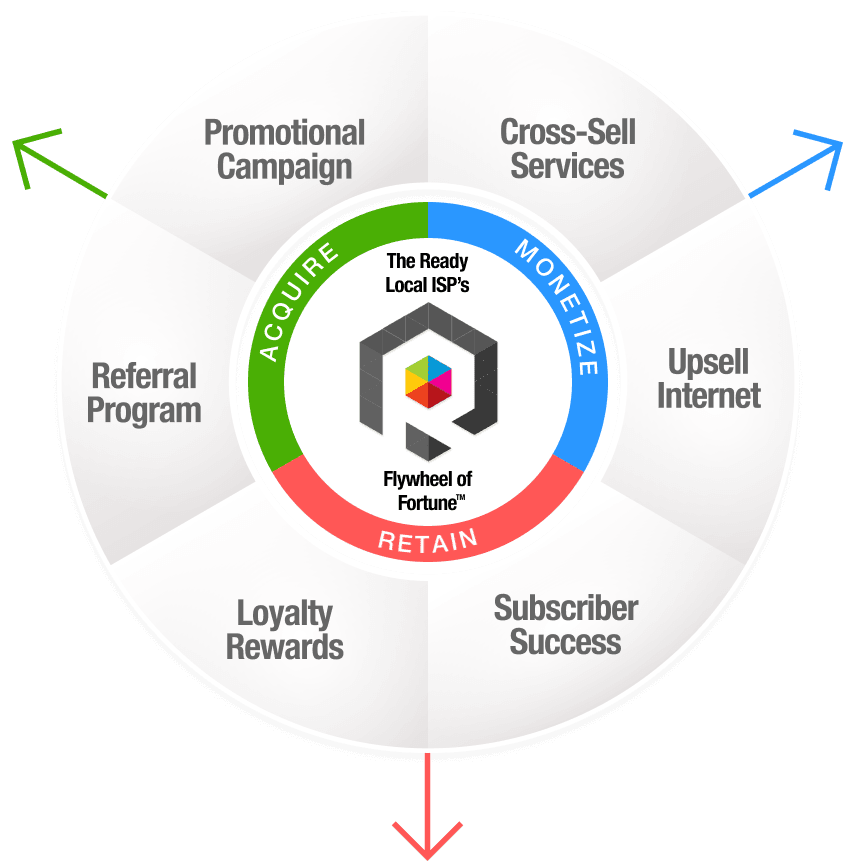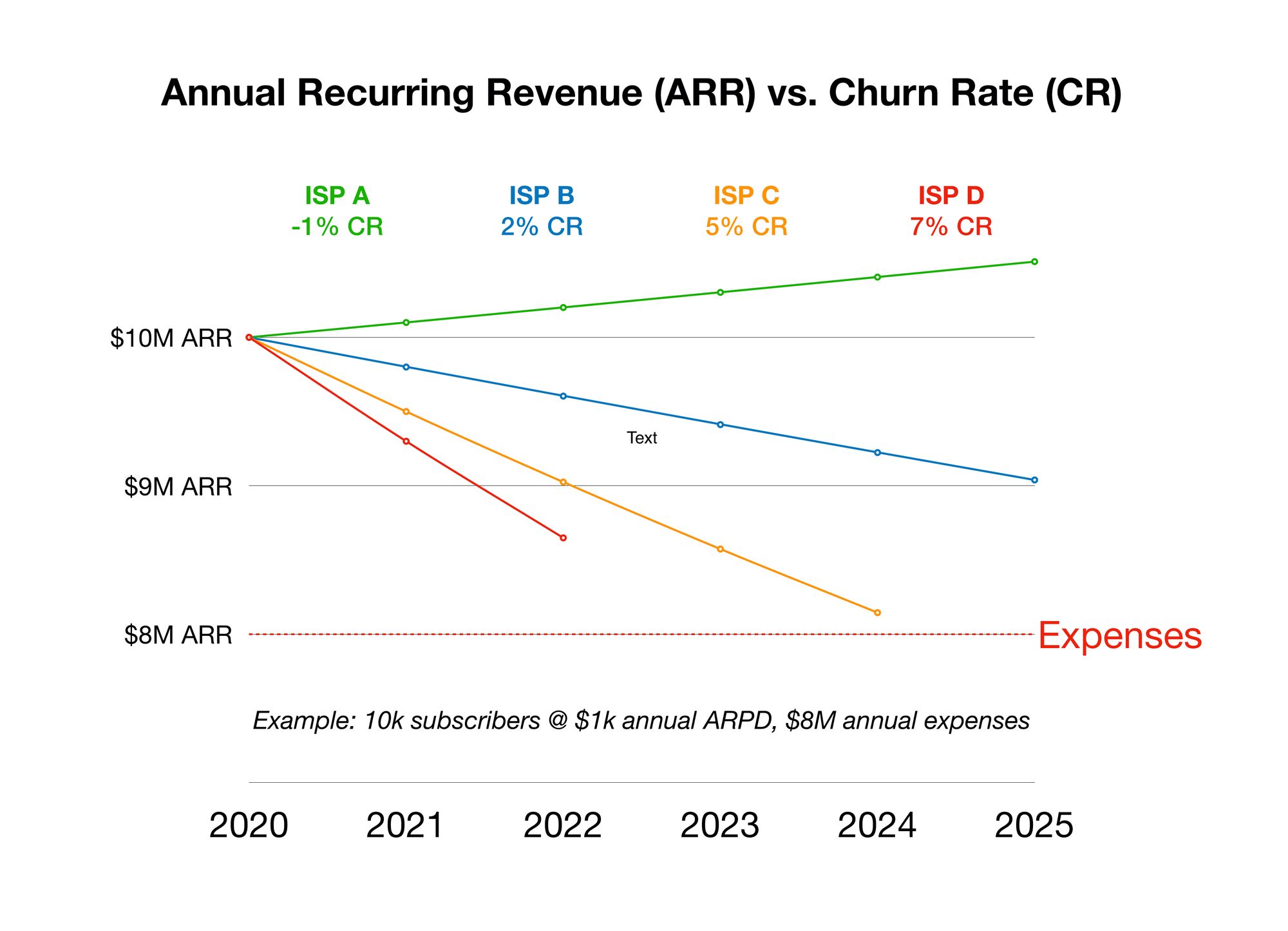
6 Ways For Local ISPs to Grow
8 min read
Local ISPs: you know how hard your job can be. Every day you work to keep folks connected, facing growing pressures from all sides: big cable stealing your subscribers. New upstarts. Rising costs. And what’ll happen when Starlink launches later this year?
You might not realize that your success grows more important every day. Because we now live in the digital services era. That bright future we all talked about in the 2010s – remote work so we can live anywhere, digital healthcare letting us receive care at home, rural jobs rebuilding our communities – it’s already here*.
One catch: it’s only available through high-performance access. Connected people and places are already racing ahead. Copper incumbents continue to fail millions of Americans, with shoddy 1990s-era infrastructure and spotty coverage. Only you – the local ISP – get the job done.
So your success is vital. But your success requires you to grow. Because four horsemen are coming for your business. And only a growth mindset – a willingness to try proven growth techniques – can defeat them.
Sadly, some of you reading this today won’t be in business in 2-3 years. The horsemen are strong.
Others among you will refuse to lose. You’ll choose to fight back. To face the new challenges. You’ll ensure every member of your community is connected to the future.
This article is for you: local ISPs with a growth mindset.
The three growth levers
Three levers govern growth in every subscription business:
- Lever A: Add Subscribers (Acquisition)
- Lever B: Build Average Revenue per Subscriber (ARPS) (Monetization)
- Lever C: Combat Churn (Retention)

Every ISP we’ve connected with at Ready already knows and understands the three levers. However, many tend to associate growing only with adding subscribers.
All three supply growth fuel: revenue. According to a Y Combinator study of subscription businesses, reducing churn is 2.3x more productive than acquiring new subscribers. And monetizing existing subscribers – increasing the average revenue per subscriber – is 3.8x more productive. Local ISP revenue fuels adding more subscribers. Keeping your subscribers happy with premium digital service cross-sells is a winning formula. Just one thing. You do not earn revenue by connecting people to the internet! It sounds crazy, but you earn revenue the same way the fastest-growing subscription businesses earn revenue, regardless of industry. Provide what your subscribers want.
Six ways to get growing
The Ready ISP’s Flywheel of Fortune™️ contains six battle-tested growth techniques. Together, they address the full subscriber lifecycle, from acquisition to loyal satisfaction.
You might use one or two today. You might’ve tried each at some point. Make an effort this year to try all six. Because they’re interconnected. For best results, creatively combine them.
The techniques are distilled from a combination of best practices used by top ISPs, and the “growth hack” secrets behind Silicon Valley’s fastest-growing companies.
The techniques aren’t rocket surgery. Nor are they magic. They just work by extending and pulling the three growth levers.
In one sense, you constantly “acquire” current subscribers. Because of that, you can apply techniques in any order. You’ll know best where to start. Let’s start with Combat Churn since churn is about to become more problematic for all local ISPs.
Lever C: Combat Churn
Churn undermines growth. The silent killer of subscription businesses. Churn occurs when your subscriber leaves you. Churn rates can seem too small to matter. Local ISP churn rates in the 2 to 5% range are common. You might be among the fortunate minority of local ISPs who presently experience no churn, as “the only game in town.” Candidly, you should worry the most, because you may face trouble in the Starlink era.


In this example, four local ISPs start 2020 serving 10,000 Subscribers, at $1,000 Average Revenue Per Subscriber (ARPS) per year, and a healthy 20% margin. ISP A nets a slightly negative churn rate by keeping gross churn low, and outpacing loss through monetization. ISP B has a low churn rate. ISP C and ISP D die without radical intervention. Of the two survivors, ISP A earns $3 Million more than ISP B over the 5-year period. With more revenue, ISP A could further add subscribers.
How can you reduce churn? Here are two battle-tested techniques:
Technique #1 Reward Loyal Subscribers
Take care of your existing subscribers. Thank them for choosing you. With rare exceptions, they don’t have to choose you. Even if you’re the only game in town today, Starlink and mesh upstarts will be knocking on your subscribers’ doors. Your subscribers might not continue choosing you unless you show them you care.
Rewarding loyalty is easy. Done well, it’s even low cost and most of the expense cycles back into your profitability.
You could do something generic, like a $25 Apple gift card, or a Thank You fruit basket (c’mon, it’s 2020, don’t do this). Always think of your Flywheel of Fortune™️. How can you find a way to re-capture 100% of the outlay? The best loyalty rewards generate demand for cross-sells and upsells. Add digital services, and incentivize your current subscribers to try them with free credit.
Alternatively, consider discounts for extended services. This is another effective reward for loyalty. You get income assurance, they get better rates the longer they commit to staying.
If you follow the next technique, you already have a great loyalty reward. When you add new services, give your subscribers who’ve been with you for more than two years a free month to try it out, at no commitment.
Technique #2 Listen to Your Subscribers
You might not offer what your subscribers want. For instance, cable uses tv to lure subscribers away from local ISPs, even if the internet service is inferior. It’s so effective that, even in the cord-cutter era, cable ISPs are growing faster than ever before. Today, more than half of connected homes in the U.S. take internet through the two largest cable companies.
How? A powerful mind trick: loss aversion bias. On average, we’re twice as motivated by a perceived loss than by equivalent gain. So, when cable makes an offer that includes internet and tv at a comparable price point, even if your subscriber doesn’t really WANT tv, even if they know they get better service from you, even if you sponsor the town’s little league team – the thought of “losing” all those channels becomes magnetic. Loss aversion is why the absence of other services like tv can subtly kill your business.
Lucky for you, your competitors condition your customers. Big cable’s meteoric rise as ISP has trained Americans to believe tv and internet go hand in hand. 96% of American homes have at least one tv. That’s why, of the universe of digital services coming online, devsiter.kinsta.cloud chose to start with digital tv that you can offer your subscribers in a white-labeled service marketplace. By offering your subscribers digital services, you’ll help them connect to new premium digital services coming online over the next few years, including live digital entertainment, digital education, and digital health. Remember: you’re the conduit.
Lever B: Build Average Revenue Per Subscriber
When you achieve technique two by offering premium digital services, you’re already on your way to building higher ARPS. Just like reducing churn, increasing revenue per subscriber isn’t complicated. There are two ways to build ARPS:
Technique #3 Upsell Subscribers More Internet
Your subscriber currently subscribes to your $50 / month, 25mb/s plan. They upgrade to $70 / month, 50mb/s plan. Congrats on the upsell.
Though obvious, it’s worth remembering as a technique. In the context of your Flywheel, you can leverage other techniques to drive demand for premium service. Video, for instance, is exceptionally bandwidth-intensive. More subscribers will need more internet. Netflix 4k requires 25mb/s average throughput. The price of 4K TVs has fallen dramatically over the last 3 years. More TVs will be 4K capable than not by the end of 2020. Once people glimpse 4K, they want it all the time. Wait til they get a look at 8K in a few years (150mb/s average per stream!).
By adding digital TV, you’ll almost certainly encounter increased upsell demand.
Technique #4 Cross-sell Subscribers Digital Services
Cross-selling happens when ISPs offer services besides the internet. TV. Voice. Knowing their value as unique services for your subscribers is key, as you’ll better recognize the new wave of emerging digital services, and the opportunity they present for you as the conduit.
It’s easy to think of adding services as a burden. Understandable: most local ISPs offering digital tv today do so through complicated, expensive rights agreements, and shoulder the full responsibility of customer service on the offerings. This is backward. The right way to think of it: you’re providing a sales channel to other digital service providers. With devsiter.kinsta.cloud, you offer services from other digital service providers and take your cut of their service through your marketplace.
In the digital services era, ISPs who embrace this can prosper by growing their total addressable market, even if it’s hard to add more subscribers. As you add new digital services, you’re no longer competing to maintain your slice of the $79 billion pie that Americans pay for internet service each year. You’re connecting folks to the fast-growing $250 billion annual market for digital services.
Where to start? Premium digital tv. Subscription TV is a $100 billion annual market. Years ago, offering tv as a local ISP involved complicated arrangements. Messy interconnections with outdated cable networks. Nasty, multi-year agreements with content providers. Now, thanks to software definition and advancements in service delivery, it’s easier than ever to offer freedom of choice to your subscribers.
Lever A: Add Subscribers
Acquiring new subscribers is the least efficient way to grow your local ISP business. But it’s vital that you do so. The following two techniques help fuel the growth of some of today’s most valuable technology companies. They can work for you, too.
Technique #5 Give Something Away for Free
Giveaways to attract new subscribers are as old as business. We love freebies! What can you give away? If you now offer a new tv service, this exciting new offering might be announcement-worthy. Send a note to neighbors, along with an offer to try the service. At Ready, we run this type of branded promotional growth campaign for you. The resulting campaigns can reach thousands of new subscribers, and generate double-digit conversion rates.
Technique #6 Incentivize Current Subscribers to Share
While your message might not go “viral” like the latest cat video, you do offer a valuable service, and many of your current subscribers will willingly recommend your service – if you give them the means and the reasons to do so.
Running a referral incentive program is easy to understand, but success requires careful coordination. Regardless of how you choose to incentivize your subscribers to share, keep in mind: the best investments help you spin your flywheel faster.

